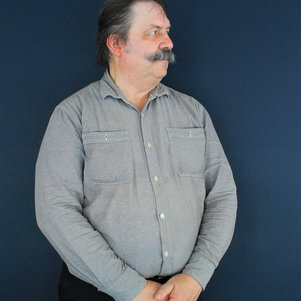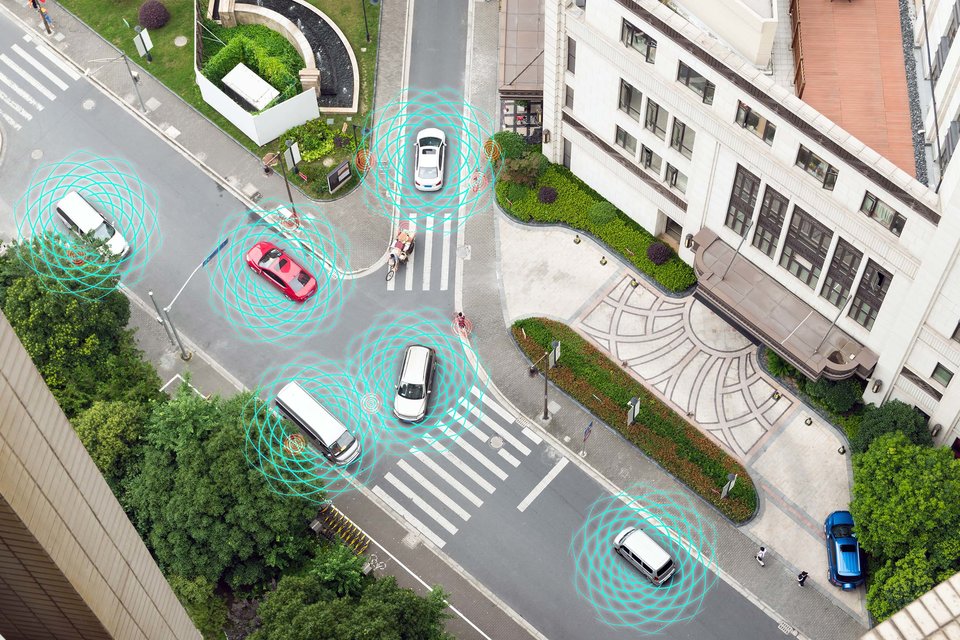Companies tell their employees to work from home. It is one of the (mandatory) measures to stop the coronavirus from spreading further. But the first week of working from home immediately led to a very high load on the networks of Dutch internet providers. Professor Earl McCune is an expert in the field of wireless communication and told us, not so long ago, about the various major challenges that lie ahead. How can we, for example, maximize the transmission of all those bits in an energy-efficient way? A question which, because of the corona crisis, suddenly became very relevant.
One of the major internet service providers told the NOS (the Dutch national broadcasting organisation): ‘We used to have a peak in internet traffic on Sunday afternoons, at the time of Formula 1 or football, but we now see this peak usage every day, all day long.’ In fact, the increase in internet traffic is so significant that the European Commission felt compelled to start a conversation with video streaming services such as Netflix and YouTube. They will now, temporarily, reduce their video quality to prevent a network overload.
With these thoughts in mind, it is even more interesting to read the story How not to waste energy on 5G, about our insatiable hunger for mobile data. And how to deal with it.
Many bits of energy make a big problem
You may be jumping with joy when your mobile phone provider quadruples your data plan each year, for the next five years. A thousand times more data sounds great. ‘But there is always a cost,’ says Earl McCune, professor in the Electronic Circuits and Architectures group at TU Delft and specialized in sustainable wireless systems. ‘All of the systems needed to provide these services, available on demand, draw power. The digital network core, the electronic systems processing and building the signals, the switching and data centres and, most of all, the transmitters and receivers.’ Three percent of the global energy demand goes into wireless communication services. And with projections of the demand for mobile data to increase a hundred to ten thousand times over the next five to ten years, we are in trouble. ‘The problem is that the communication industry in general has pretty much focused on trying to maximize the number of bits that can be transmitted per second,’ McCune explains. ‘Very little attention has been paid to the energy efficiency that goes along with that. I want to fix this.’
5G: a solution in the making
Most of the hype in wireless communications focusses on 5G – the fifth-generation cellular network technology. ‘The eventual switch to 5G comes with two major improvements,’ McCune explains. ‘One is the intended use of millimetre-wave directed beams for communication, saving lots of energy. The second improvement allows for a major increase in the speed of communications. This will enable, for example, internet of things controllable factories.’ The official goal of the 5G communications standard is a ten thousand times increase in data traffic, at flat cost and flat energy use. ‘What they didn’t tell us, however, is how to exactly implement the standard and to achieve all this,’ McCune continues. ‘We know the math behind 5G, but it simply is not yet ready to be deployed on a massive scale. In order to reach the 5G energy efficiency goal, all links in the communication chain need to be overhauled.’
Power to the signal
The present paradigm in wireless communications, laid down in 1915, is to first build a very low-power signal. It consists of the addition of many sinewaves, simultaneously carrying a few bytes of information. Next, this jumbled signal is amplified to a communications useful power level of several watts. ‘There is something called Ohm’s law,’ McCune explains. ‘It says that if you have certain signal properties, then you will not be efficient at amplifying these, particularly when you require linearity in your circuitry.’ Linearity means that the high-level output signal coming out of an amplifier is a faithful representation of the low-level input signal. To ensure linearity under all circumstances, the signal amplifiers will most of the time operate well below their maximum output level. As a consequence, the continuous effort to increase data rates has come with a continuous decrease in energy efficiency. Going from 2G to 4G, it has dropped from 60% to 20%. A twenty percent efficiency means that for every watt of useful signal, four watts of energy will just end up as heat. ‘For 5G, the efficiency will be only 10%, meaning that nine watts will be turned into heat,’ says McCune. ‘We're paying for the power, we're paying for the huge power supply, and we're paying to move that heat away into a giant block of aluminium serving as a heat sink.’ For presently rolled-out 5G using millimetre-waves, which still uses 4G hardware, the efficiency is at a mere one percent. ‘That’s even worse than the old-fashioned incandescent light bulb,’ McCune continues. ‘The old tradition of using the linear amplifier, trying to find a version that is efficient, has run its course. But, in our digital age, physics gives us another way to make an accurate signal. If you have a sampling-based system, using square signals, Ohm’s law then says you can be as efficient as you want it to be, bringing the efficiency of amplifiers up to 70%. That’s a huge improvement, just by letting go of linearity and changing the circuitry. And we don’t have to touch the signal standards themselves.’
Writing the textbook of next generation signal amplifiers
There is a catch, though. ‘We need to build these square signals at communications-useful power, not in the microwatt range,’ McCune explains. ‘There is no textbook explaining how to build a sampling system at power. We’re going to be writing that.’ Being both a part-time professor at TU Delft and part-time consultant and entrepreneur in California, McCune is involved in two separate approaches to build these untraditional amplifiers. In Silicon Valley, he pursues the idea of building one big switch, adjusting the power that is made available to it. Here at TU Delft, his group and two more groups will work on a solution consisting of hundreds of smaller transistors, in varying sizes. ‘It’s like playing a very big organ, adding the power signals up to make the desired output,’ McCune explains. ‘To have both a high accuracy and high efficiency, the transistors must switch on and off at a much faster speed than the carrier signal that is being sampled.’ Such power switches are already available for the lower range of 5G frequencies, below 6 GHz. But most of the unused 5G bandwidth is the millimetre wave bands, having frequencies above 24 GHz. ‘This requires the power supply to switch at speeds of at least 600 GHz,’ McCune says. ‘We don’t yet have transistors with this capability and need to improve them by another threefold or more.’
In order to reach the 5G energy efficiency goal, all links in the communication chain need to be overhauled.
No time to idle
It’s not just the power supply for amplifying the wireless signals that has to be revisited. ‘On average, when switched on, your desktop computer is not performing any useful tasks for 96% of the time,’ says McCune. ‘Likewise, the components making up the digital core of the communications network – the switching and data centres – are idle about 72% of the time. The logic components in the computer switch about a million times faster than the power supplies presently used. To have immediate performance when needed, we just leave the power on.’ His proposed solution is quite like the modern cars that turn off and back on when waiting at a traffic light. It takes so little time that it doesn’t interrupt your driving experience. ‘We can already build the power supplies that respond in less than one microsecond,’ McCune continues. ‘The problem is that the computing chip community has interleaved their computer logic circuitry with some of the memory. Switch your computer off, and you’ll erase a part of its memory too. We have to slightly rearchitect the chips, separating memory from logic. Then, we can reduce computing power consumption by a factor of four, saving millions of euros.’
Line of sight communications
Probably the most hyped promise of 5G telecommunications is the use of directional beams for communication, transmitting power only where you need it. The present 4G network relies on antenna’s that put out their radio signal across vast areas. As you move around campus, you’ll always find the same signal everywhere. ‘From a transmitter point of view, that is silly,’ says McCune. ‘This way, almost all radiated power is just going to warm up the grass. Using directed power, the antenna will create small beams, sending radio waves of the same strength only to where you are. When you move around, it will follow you like a theatre spotlight.’ It works a bit like the satellite dishes used for satellite communications. But instead of parabolic antennas, it takes the coordination of hundreds of small antennas to create a beam covering only a very small segment of the sky. ‘It is solved, but only in computer simulations,’ says McCune. ‘It will take some years for it to work in real-time in the real world, especially for 5G in the millimetre wave bands. The signal will be interrupted by bouncing off spinning windmills, cars driving by, the buildings people enter and exit. Even you yourself are a reflector, as millimetre-waves cannot penetrate the human skin.’
The love for building things
One evening, when McCune was twelve, his now late father explained a few months’ worth of network theory of electrical circuits to him. ‘He was a good explainer, and it just made sense,’ says McCune. He now has more than 45 years of experience in technology development in the field of radiofrequency and wireless design, most of which he spent in industry. ‘I just love to build things,’ he says, ‘and I have seen a lot of what works, and what doesn’t work.’ Enjoying an early retirement in California, but still wanting to help solve societies problems, he accepted a professorship at TU Delft. ‘When pressured, industry will change its technology only incrementally, just enough to keep making money. I thought we were missing something, there’s so much room for big improvements.’
The Fly’s Eye project
‘Now here’s a challenge,’ McCune says. ‘Imagine the world cup soccer final with eighty thousand spectators who all, simultaneously, want to post their own high-resolution video of the winning goal. Can we do that?’ This is what the Fly’s Eye project is about, one of the ongoing TU Delft projects McCune is now involved in. ‘It is very multi-disciplinary, with Nuria Llombart-Juan from the Terahertz Sensing group as the lead researcher,’ he says. ‘Instead of having spots moving around the stadium, the idea of the Fly’s Eye is to “just make a lot of spots”, covering the entire stadium. We simply hand the signal off to the next spot, should a user move around too much.’ One of these passport-photo-sized spots is already being tested in the lab. It consists of a bunch of transmitters covered by a clear plastic lens that is able to focus radio waves in the millimetre-wave spectrum. The eventual structure will have 1500 of these spots, their beams partially overlapping. At just over a meter in diameter, it will hang in the middle of the stadium. To handle the massive amount of wireless data, a bundle of optical fibres will connect the Fly’s Eye to the internet, much like your optic nerves are the communication highway between your eyes and your brain. ‘I just love the eye metaphor,’ McCune says.
Only a few minutes to dump satellite memory
McCune is also intrigued by the communications problem posed by cubesats. These tiny satellites, consisting of up to a few ten-centimetre cubes, are cheap to build and to bring into earth orbit. They are often equipped with one or more camera’s for earth observation, collecting huge amounts of data. At their altitude of 500 kilometres they move so fast that direct line of sight communication with a ground station is severely limited. ‘We have only a few minutes to transmit gigabytes of data, and there are some very limiting constraints,’ McCune explains. ‘There isn’t much energy available in a ten-centimetre cube. The antenna can’t be very big either, limiting us to high radio frequencies. Then, there’s the oxygen in earth’s atmosphere, which is very efficient at absorbing millimetre wave radiation.’ His voice sounds more and more enthusiastic with every added challenge he mentions. ‘It’s a 5G type of problem,’ he says. ‘It involves energy, antennas, all kinds of things. To boost efficiency from two percent to fifty percent, we have to overhaul everything.’





